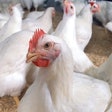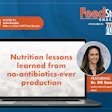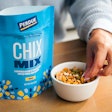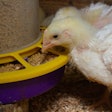Modern broiler production already appreciates the value of a high-density pre-starter feed. Such "super" feeds not only enhance early growth, but they also improve lifetime performance. In systems where antimicrobial and anticoccidials agents are banned by law or excluded by preference from broiler feeds, such super pre-starters appear to require further modifications.
When gut-conditioning agents are used, there is no reason to minimize undigested feed nutrients, especially if high-nutrient density can be achieved by using less expensive ingredients. For example, a high-density pre-starter can be achieved by using normal levels of soybean meal and high(er) levels of feed-grade amino acids, such as methionine, lysine, threonine and tryptophan. But, such feed would not work when the usual gut conditioning agents are removed. This is because soybean meal is imperfectly digested, allowing a good part of excess crude protein to reach the hindgut and serve as substrate for proteolytic microorganisms, which also happen to include the most dangerous pathogens. Thus, antibiotic- and anticoccidials-free nutrition programs must ensure minimal undigested material, and especially protein, reaches the hindgut. To this end, soybean meal (or other similar conventional protein source) must be reduced and replaced by other protein sources. Such ingredients should be of the highest possible digestibility.
In essence, drug-free broiler nutrition programs must use additives that control pathogens and specialty ingredients that minimize the chances of pathogen growth. The most commonly used additives and ingredients used for this purpose are the following five:
1. Organic acids
Perhaps the most well-established line of additives that can replace antibiotics are organic acids. They include a wide range of products that act at different parts of the gut depending on their pKa chemical trait and local pH at gut level. Among them, butyric acid, or rather a salt of butyric acid or protected butyric acid (as it smells horribly in pure form), is favored because it also acts as a trophic agent for gut villi that are involved in nutrient digestion and absorption. Most experts would agree that such function is mostly welcome in cases of damaged gut condition, as it happens during and after certain gut disorders. The level of organic acids required to fully control pathogens throughout the gut is a matter of debate, but original research indicated levels exceeding 10 kg per metric ton, whereas current commercial practice call for 1-2 kg per metric ton.
2. Phytogenics
These are plant-extracted compounds with a wide range of functions, including pathogen control, at different levels and modes of action. There is a great range of products in the market, in free or encapsulated form, with a wide coverage of possible actions. Thus, the use of such ingredients is recommended only after testing them at each specific farm. Some research exists to indicate that a combination of phytogenic compounds and organic acids is the best possible combination: phytogenics increase the penetration level of organic acids that disrupt pathogen internal functions, leading to their death.
3. Hydrolyzed proteins
These are highly digestible protein sources, such as wheat gluten, or marine proteins (other than fishmeal). The benefit of using such proteins instead of soybean meal is that of super high digestibility and lack of associated anti-nutritional factors. Their high price excludes them from most cost-sensitive formulas, but they can be used at moderate levels in broiler super pre-starters to enhance protein digestibility. Hydrolyzation is not always essential, but it offers a further boost to an already high digestibility of protein, albeit at an added cost. Soy protein concentrate and isolate are also two interesting ingredients to consider for such feeds, as is fermented soybean meal. Nevertheless, the issue of anti-nutritional factors from refined and modified soybeans requires to be elucidated.
4. Animal plasma
Animal plasma is a component of blood. It is a rich source of protein (up to 80 percent), all of which is highly digestible. As such, it competes easily with the best protein sources. But, animal plasma also has an added benefit not found in other proteins: it contains biofactors, such as immunoglobulins, that have been shown to enhance gut health, by a number of different ways. In fact, animal plasma is used as a standard ingredient in young pig diets as a source of such biopeptides; piglets grow more and eat more when their feeds contain such components. Thus, it is logical to assume that in broilers plasma will exert the same effects. To this end, animal plasma will be valued by this dual role. Indeed, first commercial field results indicate that the use of animal plasma in broiler super starters can minimize the need for high levels of the ingredients mentioned above, including organic acids and phytogenics.
5. Enzymes
Enzymes are well-known additives in poultry nutrition. The most frequently used are those against the non-starch polysaccharides found in cereals such as wheat and barley. Using them also in broiler super pre-starters is recommended, but not essential, especially if maize or high quality wheat and barley are used. The use of a protease can be justified if unrefined protein sources, such as soybean meal, continue to dominate the protein supply in broiler super pre-starters, but again, they are not essential if refined protein sources and/or animal plasma are used at moderate to high levels. Clearly, this is a new territory requiring further investigation. At the moment, if cost is not an issue, using such enzymes will not hurt, and most likely benefit broilers early in their life.
In brief
There are many ingredients and additives that can be used to design a broiler super pre-starter. The design of such feed will be different when it is to be part of a drug-free nutrition program. In such cases, not only alternative anti-pathogen agents are required, but proteins of high digestibility are also a must. Among them, animal plasma can provide a double function as a gut health agent, in addition to being highly digestible. Whether it is used or not, it depends on the cost sensitivity of the designed feed.

















